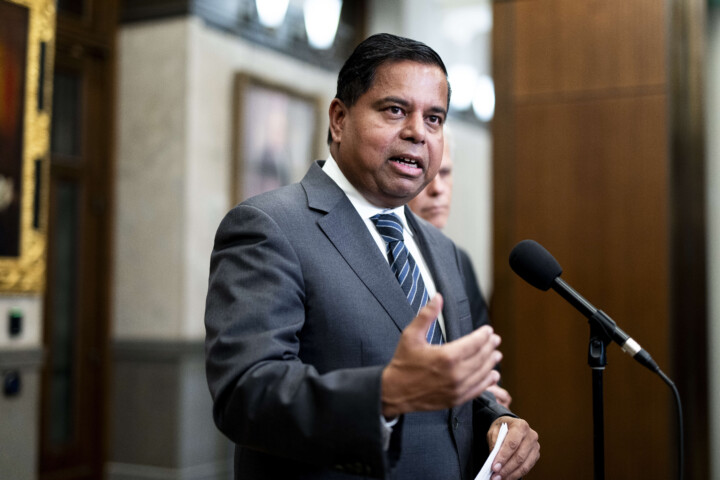Later this week, the Canadian federal government will, through the Bank of Canada as agent, purchase $3.75 billion of 10-year duration Canadian Mortgage Bonds (CMBs) in a syndicated transaction.The notice detailing this can be found here. The upcoming CMB purchase is the first of what is intended to be an ongoing program in which the government will purchase half the CMB issuance going forward: $30 billion in 2024 alone. This is not quantitative easing—a monetary policy tool by which the central bank purchases term assets by creating reserves. Rather, it is fiscal policy: the federal government plans to expand its general borrowing program in order to purchase financial assets.
If future government(s) persist with purchases at this pace, they will eventually own half the CMB market—or about $200 billion in term assets. The government either believes that CMBs are their own obligations and that these purchases sterilize debt, or that it is good public policy to expand borrowing $30 billion annually (about 75 percent of the federal deficit) in order to purchase financial assets. CMBs are included (incorrectly, I would argue) in both the reporting of net federal debt and the Borrowing Authority Act (the Canadian equivalent of the U.S. debt ceiling but not nearly as politicized.)
In my view, CMBs are not actually federal government liabilities. This distinction has important consequences. If CMBs aren’t federal debt, then the currently planned $30 billion in CMB purchases this year is a significant policy shift that I believe is deeply misguided.

What are CMBs?
Eligible Canadians taking out mortgages will often need to purchase mortgage insurance in order to obtain an “acceptable” interest rate on their mortgages (this mostly applies those without access to large down payments). The largest provider of this mortgage insurance is the Canadian Mortgage and Housing Corporation (CMHC), a federal crown corporation. Mortgage lenders originate CMHC-insured mortgages and package them into complicated prepayable instruments known as National Housing Act Mortgage Backed Securities (NHA MBS). The NHA MBS then needs to be sold to financial markets in order to obtain the actual cash to be lent to the homeowners. CMHC raises some of these funds in a very efficient way via the Canada Housing Trust (CHT)—a conduit that purchases NHA MBS in hedged form and funds those purchases by issuing simple market-friendly fixed-rate bonds known as CMBs.
CMHC earns profits by selling mortgage insurance for much more money than it loses in claims. The profits of CMHC (over $1 billion last year) are remitted to the Government of Canada. The approximately $250 billion of outstanding CMB debt is explicitly government-guaranteed in that their underlying cashflows are insured by a crown corporation, but they are very clearly liabilities of the Canadian Housing Trust, not the federal government.
There is no line item in the federal budget for CMB interest payments or return of principal, and the government has never seen the proceeds from their issuance.The proceeds are used by CHT to purchase the NHA MBS which have sent the funds to households CMB interest payments are in the financial statements of CMHC, and they are offset by interest received from NHA MBS—since the CHT is a pass-through conduit, risk to the government of Canada from CMHC would only materialize if CMHC found itself in a negative equity position due to it materially underpricing mortgage insurance. This would be the public sector equivalent of an insurance company needing to be recapitalized. In this remote scenario, the federal government’s ultimate liability is still far less than the amount of CMBs outstanding; underlying debts are first-lien mortgages that have full recourse to the homeowner(s).
When the federal government executes its plan to purchase CMBs it will essentially be lending money to homeowners instead of merely collecting insurance premiums from them via CMHC. The idea that the government would or should purchase CMBs originated in the 2023 federal budget. When I wrote about this soon after that budget, it wasn’t clear if the government misunderstood the complicated nature of the CHT or actually viewed the potential purchases as a way to make money via a perceived financial market arbitrage opportunity (because CMBs are issued at a spread to federal government debt). It also wasn’t obvious whether CMB consolidation meant an effective end to the program.
After the budget, the Department of Finance conducted consultations with many stakeholders who overwhelmingly advised the government not to end the CMB program and broadly championed the importance of the CMB program to the Canadian residential mortgage market.See here, here, and here. While the consultations were ongoing, the Department of Finance seemed to reverse course, announcing that the program would increase by 50 percent, from $40 billion annual CMB issuance in 2023 to $60 billion in 2024, to promote “affordable housing.” Finally, in the November fall economic statement, the government indicated its intention to purchase half of the future CMB issuance.
Policy upheaval leads to market volatility
The policy upheaval over the last year in CMBs has induced a significant amount of market volatility in the bonds. Upon the announcement the program might be cancelled, CMBs richened as one would expect. CMBs subsequently cheapened when the program size was instead raised from $40 billion to $60 billion; they then reversed course and richened again as the market correctly anticipated the government’s intention to purchase half of them. The increased volatility, combined with the now relatively lower CMB rates (and higher bond prices, because the government is now signaling that they are an uneconomic buyer of $30 billion CMBs annually), has convinced some international investors to exit the CMB market, removing foreign capital from Canada. Some institutional investors now consider CMBs to be “un-investable” because the policy volatility will remain even after the purchases begin.

There is absolutely no guarantee that the CMB purchases will continue after a change in government, which would remove the price-insensitive buyer and cheapen the bonds again. This is certainly a possible outcome, as other advanced economies simply don’t take fiscal actions like this. The United States Congress doesn’t appropriate funds to purchase U.S. government-guaranteed Ginnie Mae mortgage-backed securities. Germany doesn’t issue bonds to purchase the debt of Kreditanstalt für Wiederaufbau, an organization whose bonds are explicitly guaranteed by Germany. The current Department of Finance has not uncovered a new financial strategy that the world’s largest government bond issuers have so far ignored.
How will it turn out?
It is also impossible to predict whether the imminent CMB purchase strategy will make or lose the government money over time. The government will earn on the spread between CMBs and Canada bonds, and these earnings may or may not be exceeded by increased issuance costs due to the growth in federal borrowing. Canadian federal debt has recently cheapened relative to other interest rates (meaning it is now broadly more costly for the federal government to borrow). This partly reflects the expected increased supply of government bonds that will be needed to purchase $30 billion CMBs annually. The planned CMB purchases are of five- and ten-year duration assets, but the government has not yet announced any proportional increase in the issuance of five- and ten-year terms to offset the interest rate risk inherent in these purchases. It instead seems intent on continuing to issue large amounts of shorter-duration liabilities: two-year bonds and treasury bills.
The government seems to be planning to “borrow short and lend long,” akin to speculating on interest rates falling—a strategy that will lose money if the forward path of interest rates turns out to be higher than current market expectations. Nothing has been published detailing how this will be tracked and accounted for. The Bank of Canada is currently in a negative equity position due to the bond portfolio it acquired while performing monetary policy via “quantitative easing.” It tracks its losses carefully and can project them into the future. Will the Department of Finance provide similar transparency? It is not an asset manager with a dedicated asset-liability management team. Nor is it a hedge fund that borrows money to purchase financial assets. Instead, it is a sovereign whose principal market function is to sell bonds to finance federal government activities according to a predictable schedule, anchoring Canadian fixed-income markets.
The federal government is ultimately responsible for the risks incurred by CMHC’s mortgage insurance business since CMHC is a crown corporation. But if you insure a security, it doesn’t follow that you should also purchase it. Sovereign governments of advanced economies explicitly guarantee, implicitly guarantee, and insure many activities they do not directly control or finance. In Canada, besides CMBs, there are many other fixed-income securities that are either explicitly government-guaranteed or are highly likely to be federally government supported in the event of default. The most salient example is the NHA MBS securities that were not securitized as CMBs and could be purchased at higher yields than CMBs.
Continued confusion
Why doesn’t the federal government borrow money to purchase all of the higher-yielding, explicitly and implicitly guaranteed bonds as well? That would be logically consistent with a plan to purchase all the CMBs—but perhaps not with a plan to buy exactly half of them. Perhaps NHA MBS purchases weren’t considered simply because the Borrowing Authority Act doesn’t include NHA MBS, which are identical to CMBs as a credit. The federal government has traditionally borrowed money only to fund its own spending and fiscal transfers. Other borrowers access the capital markets at market-determined rates, which are higher than where the sovereign borrows. CMB’s rates will now be distorted because Ottawa plans to be an uneconomic buyer of half of them. The current policy suggests continued confusion as to the nature of CMBs as liabilities.
It has been argued that the government needs to purchase CMBs in the marketplace because it has just increased annual CMB issuance from $40 billion to $60 billion and that this has material benefits for affordable housing construction. This is false. The CMB market cheapened only about 10 basis points on a relative basis (0.1 percent), but certainly didn’t break down when the issuance target was unexpectedly raised to $60 billion and government purchases weren’t yet widely anticipated.
The motivation for how the government determines the annual CMB target (cap) is also opaque. Recall that all CMB issuance represents is a transformation of insured mortgage debt from NHA MBS into fixed-rate bonds via the CHT. The ultimate risk to the government is the amount of total mortgage insurance underwritten at CMHC and the quality of that process, not the notional amount of CMB issuance itself. Global capital markets will find a clearing rate for whatever amount of CMBs are issued. Eliminating policy volatility from this process would improve this rate over time and encourage global investors to return to the market.

Why this matters as housing policy
Finally, let us now comment on this as housing policy. The upcoming CMB purchases are best described as credit easing via fiscal policy. The government will be borrowing additional funds to ease financial conditions for one specific type of borrower: Canadians who take out insured mortgages. For these borrowers, CMB purchases act opposite to the current stance of the Bank of Canada, which is still tightening policy to fight inflation (not by raising rates but by continued “quantitative tightening” and maintaining a high terminal overnight rate of 5 percent, which becomes more restrictive as inflation falls). The market impact so far on the announced plan to purchase CMBs has only been about 15 basis points or 0.15 percent. Given that the Bank of Canada has increased the overnight rate by 475 (4.75 percent) basis points during this cycle to fight inflation, it is hard to believe that the federal government borrowing an additional $30 billion, to offset this monetary tightening by a mere 15 basis points for a subset of borrowers, is part of the correct public policy mix to fix our supply-constrained housing market.
Suggestions for current and future policymakers
1. No one in government has provided any publicly available detailed explanation for the policy rationale behind these proposed purchases. This suggests that the current government may have been badly advised or is simply unfocused on a complicated file. The proposed purchases undermine Canada’s credibility in global fixed-income markets. You can choose to stop this. End the confusion and remove the outstanding CMB bonds from your reported net debt. Amend the Borrowing Authority Act to remove CMBs. The government of Canada did not issue them, never collected their proceeds, does not pay interest on them, and does not need to return their principal upon maturity.
2. Change how the amount of annual CMB issuance is determined. To achieve every efficiency, the amount should be large enough so that most originated NHA MBS make it into the CHT. The growth of the CHT should be slow, predictable, and determined by economic and market forces. The $1 million dollar cap (which is now too low for most of the GTA and Vancouver) on CMHC insurance eligibility should also rise annually, based on some measure of growth. The most important risk consideration should be the size and methodology of the insurance underwriting at CMHC. Market structure changes should be motivated by the work of technocrats and experts, likely coordinated by the team at CMHC in a deliberative and apolitical manner.
3. Mandate and motivate the CMB syndicate (the large banks that sell CMBs to bond investors) to market them aggressively to long-term foreign investors. Collaborate with sophisticated provincial bond issuers in this effort. Reinforce it by making both Canadian government bond and CMB issuance more consistent and predictable. Global bond investors seek open economies with stable long-term issuance patterns, a record of fiscal discipline, and low inflation. Deliver this in Canada for the common good.
Recommended for You

Letter to a minister: It’s time to make public safety a priority

The maximalist Charter: The problem of instrumental rationality

The Weekly Wrap: Is Trudeau to blame for Carney’s disappointing budget?

‘There’s still another shoe to drop’: The Roundtable on Carney gunning for a majority and doubts about Poilievre’s leadership



